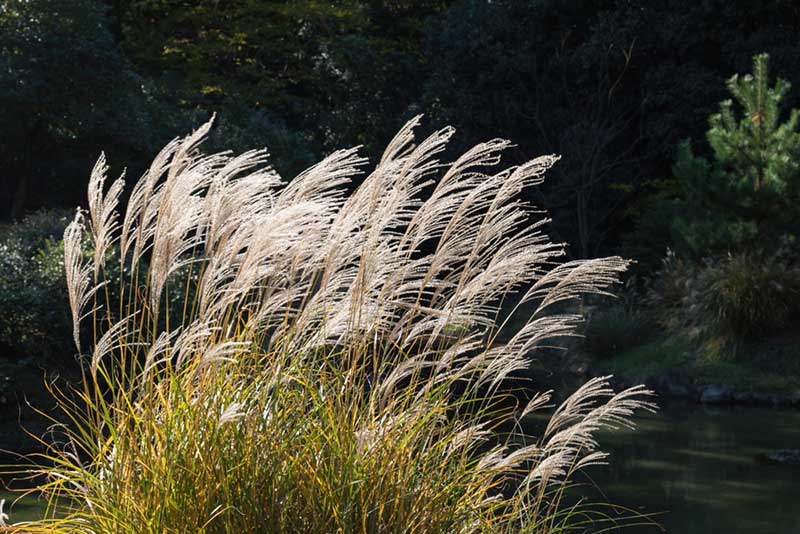
Japanese silver grass is an ornamental grass that comes in several different varieties that have different heights. There are smaller varieties that may only reach 3′ tall, and there are varieties that get at least 10′ tall.
They look great all year long, and they are perfect as the focal point of a garden, or they can be used as a hedge instead. They will grow easily in zones 5 through 9.
Japanese silver grass grows an inflorescence that looks feathery and has a light silvery gray color. The plant’s blades grow closely together and form tight clumps. In the fall, the foliage will take on a reddish shade, and the inflorescence will stay in place, giving the plant a festive seasonal look.
There are also varieties that grow flowers in pink or red. It’s a hardy plant and needs very little maintenance other than being watered. They do not typically get infested with pests.
Japanese Silver Grass Care
Light and Temperature Requirements
These plants will tolerate partial shade, but they prefer to be in full sun. They may not be as strong in partial shade, but they can thrive there. Often, a partial shade area will result in a plant that is floppier than it would have been in full sun and may have a less-intense color.
Japanese silver grass can go dormant in the winter, and in this state they can tolerate a temperature as low as -5. They don’t handle spring frost as well, however, as this can freeze new-growth areas. They are tolerant of areas with strong winds.

Watering
This plant prefers to have soil that is always moist but not soggy. Feel the soil’s surface every once in a while, and water it if it is dry. An established Japanese silver grass plant will be able to survive through droughts, though it would prefer to have more moisture. When watering this plant, use the drip method on the soil rather than watering it from the top. Too much moisture on the blades can lead to a fungal infection. Top-down watering may also keep water from getting all the way down to the roots.
Soil & Fertilizing
A fertile, loamy soil is preferred by this plant, but it will grow in nearly any soil type that has good drainage. They also prefer moist areas over dry. The Japanese silver grass is not picky about the soil’s pH. The plant should not need any fertilizer for its first year as long as the soil is relatively good. Once the plant has been established for a year, you can add organic fertilizer to the soil during the summer. This will allow it to grow faster and to bloom more.
Deadheading and Pruning
This ornamental grass generally goes dormant in the winter, and that’s the perfect time to prune it. For the larger varieties, first tie them in the middle so that the ends are off the ground and you have a straight place to prune across the plant.
Then, use hedging shears to cut through the plant, leaving it about 8″ to 10″ tall. The blades of this grass can be sharp, however, so wear gloves and possibly arm protection when you prune this plant. It does not need deadheading.

Propagating Japanese Silver Grass
Japanese silver grass is easily propagated through division and should be done every three to four years when the center of the plant begins to show signs of dying back.
Simply use a spade to dig up the entire clump, then use a sharp shovel or knife to cut the clump into multiple sections with at least four or five healthy roots on each.
These new sections should be immediately planted and watered well. As they have a tendency to spread, be sure to space plantings several feet apart.
Fertilizing
Japanese silver grass does not have an appetite for heavy fertilization as too much will tend to make the stems floppy and weak and unable to hold up to the cold winds of winter.
An annual application before new growth appears of 1/4 to 1/2 cup of all-purpose, balance fertilizer with a 10-10-10 ratio is generally sufficient.

Japanese Silver Grass Companion Plants
As the splendor of maiden grasses are most obvious during the season of autumn, they pair well with colorful fall plants such as chrysanthemums and asters. And despite originating from Asia, they are a natural fit with native field flowers such as Heliopsis (sunflowers), coneflowers, and goldenrod.
Is Japanese Silver Grass Invasive?
In some parts of the country, the Japanese silver grass is considered invasive.
You can still, carefully, plant this ornamental grass in your landscaping, but be sure that you keep it from getting out of hand and encroaching on other areas.
If you prune it every winter, you can keep its growth under better control so that it doesn’t spread to other properties.




